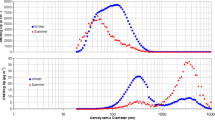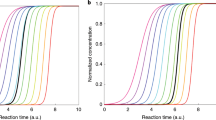Abstract
A size-specific aerosol dynamic model is set up to predict the evolution of particle number concentration within a chamber. Particle aggregation is based on the theory of Brownian coagulation, and the model not only comprises particle loss due to coagulation, but also considers the formation of large particles by collision. To validate the model, three different groups of chamber experiments with SMPS (Scanning Mobility Particle Sizer) are conducted. The results indicate that the advantage of the model over the past simple size bin model is its provision of detailed information of size spectrum evolution, and the results can be used to analyze the variations of number concentration and CMD (Count Median Diameter). Furthermore, some aerosol dynamic mechanisms that cannot be measured by instrument can be analyzed by the model simulation, which is significant for better understanding the removal and control mechanisms of ultrafine particles.
Similar content being viewed by others
References
Wang W, Liu H J, Yue X, et al. Study on size distributions of airborne particles by aircraft observation in spring over eastern coastal areas of China. Adv Atmos Sci, 2005, 22(3): 328–326
Zhang R J, Wang M X, Fu J Z. Preliminary research on the size distribution of aerosols in Beijing. Adv Atmos Sci, 2001, 18(2): 225–230.
Wagner P E, Kreyling W G, Semmler M, et al. Health effects of ultrafine particles. J Aerosol Sci, 2004, 35(Suppl 2): 1155–1156.
Donaldson K D, Brown A, Clouter R, et al. The pulmonary toxicology of ultrafine particles. J Aerosol Med, 2002, 15(2): 213–220
Thatcher T L, Layton D W. Deposition, resuspension, and penetration of particles within a residence. Atmos Environ, 1995, 29(13): 1487–1497
Nazaroff W W, Cass G R. Mathematical modelling of indoor aerosol dynamics. Environ Sci Tech, 1989, 23(2): 157–166
Morawska L, He C, Hitchins J, et al. Characteristics of particle number and mass concentrations in residential houses in Brisbane, Australia. Atmos Environ, 2003, 37(30): 4195–4203
Lai A C K, Nazaroff W W. Modeling indoor particle deposition from turbulent flow onto smooth surfaces. J Aerosol Sci, 2000, 31(4): 463–476
Wexler A S, Lurmann F W, Seinfeld J H. Modelling urban and regional aerosols I. Model development. Atmos Environ, 1994, 28(3): 531–546
Max Zhang K, Wexler A S. Modeling the number distributions of urban and regional aerosols: Theoretical foundations. Atmos Environ, 2002, 36(11): 1863–1874
Kittelson D B. Engines and nanoparticles: A review. J Aerosol Sci, 1998, 29(5–6): 575–588
Gidhagen L, Johansson C, Strom J, et al. Model simulation of ultrafine particles inside a road tunnel. Atmos Environ, 2003, 37(15): 2023–2036
Pyykönen J, Jokiniemi J. Computational fluid dynamics based sectional aerosol modelling schemes. J Aerosol Sci, 2000, 31(5): 531–550
Fuchs N A. The Mechanics of Aerosols. London Pergamon Press, 1964
Hinds W C. Aerosol Technology: Properties, Behavior, and Measurement of Airborne Particles. New York: John Wiley & Sons Inc, 1982
Lai A C K. Particle deposition indoors: A review. Indoor Air, 2002, 12: 211–214
Morawska L, Jamriska M, Bofinger N D. Size characteristics and ageing of the environmental tobacco smoke. Sci Total Environ, 1997, 196(1): 43–55
Fine P M, Cass G R, Simoneit B R T. Characterization of fine particle emissions from burning church candles. Environ Sci Tech, 1999, 33: 2352–2362
Klepeis N E, Apte M G, Gundel L A, et al. Determining size-specific emission factors for environmental tobacco smoke particles. Aerosol Sci Tech, 2003, 37: 780–790
Sun Z, Huang Z, Wang J S. Studies on the size distribution, number and mass emission factors of candle particles characterized by modes of burning. J Aerosol Sci, 2006, 37(11): 1484–1496
Author information
Authors and Affiliations
Corresponding author
About this article
Cite this article
Sun, Z., Huang, Z. & Wang, J. Experimental and modeling studies on number and size spectrum evolutions of aerosol particles within a chamber. CHINESE SCI BULL 52, 1302–1306 (2007). https://doi.org/10.1007/s11434-007-0180-6
Received:
Accepted:
Issue Date:
DOI: https://doi.org/10.1007/s11434-007-0180-6




